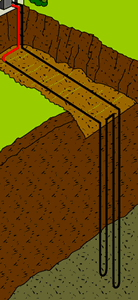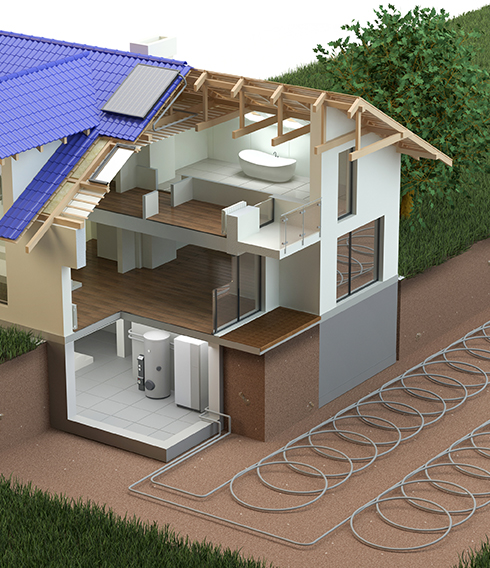What is Geothermal?
Welcome to GeoThermal heating and cooling – a new era of home comfort! While the name may sound like something from Star Wars, the technology is proven, down-to-earth technology that has been around a whole lot longer than Star Wars. Read on to learn more about how using geothermal to heat and cool your home can significantly lower your energy bills.
How does geothermal work?
A geothermal heating and cooling system works on the simple fact that the earth below the frost line (In Iowa around 4 feet down) is a constant temperature of around 50 degrees year round. Using the principles of refrigeration, heat can be taken from the ground and transferred through a heat pump to the air in your home during the winter. In the summer, the process is reversed and the heat in your home is transferred to the ground to cool your home.
  |

What are the benefits of geothermal?
- The heat pump, engineered off of traditional refrigeration compressors, is self-contained, installed indoors and is extremely reliable.
- The ground loop piping is engineered for a very long life; many manufactures warrant their piping for 50 years.
- The ground loop piping is joined using thermal fusion (melting the joints together)virtually eliminating any chance of liquid leaks
- There are no “on” or “off” cycles thus no temperature fluctuations
- There are no ugly, noisy outdoor condenser units as found in traditional air conditioning
What about energy savings?
Since geothermal units operate by moving heat, not generating heat, the only energy needed is for moving that heat between the earth and your home. Many geothermal owners find that they have lowered their heating bills by up to 50 percent and their cooling bills by up to 30 percent.
For extra energy savings, you can add a “desuperheater” that connects your geothermal heat pump to your water heater. Unneeded energy from the heat pump is diverted to your water heater which means that in most cases in the summer you’ll be getting nearly free hot water.
How about really cold weather?
Modern geothermal units work extremely well in below zero weather and when the equipment and ground loops are sized properly by your geothermal dealer, electric resistance back up is not needed. The geothermal system for your home should be custom designed to account for your local climate and your home’s heating/cooling load. Geothermal systems are very efficient in Iowa’s climate and work as efficiently as those geothermal systems installed in southern zones.
As with any heating and cooling system, adequate insulation and weatherization are still key factors in lowering energy consumption.
Is geothermal heating and cooling only for homes?
No. Geothermal can be used in nearly any heating or cooling application ranging from large commercial buildings, schools, churches to entire university campuses such as Ball State University.
Geothermal systems have been shown to have competitive installation costs, lower operating and maintenance costs, as well as the lowest life-cycle costs when compared to other systems.
Main elements of a geothermal system include:
- Buried loops of plastic piping (either horizontal or vertical) call the ground loop
- A biodegradable liquid antifreeze
- A pump to circulate the antifreeze through the ground loop
- A heat pump
The ground loops are buried in the ground and are connected to the circulating pump inside your home. The pump circulates the water-biodegradable antifreeze through the buried ground loops and the liquid mixture absorbs heat from the ground as it circulates through the loop. The heat pump takes the heat from the liquid and transfers it to the air in your home. The cooling process works in reverse; the heat in your home is transferred through the heat pump into the liquid which is then absorbed back into the earth.
Tell me about ground loops
The loops of plastic piping can be installed either vertically or horizontally depending on the location of your home. The amount of piping needed depends on the size of your home and the loop configuration. Your geothermal contractor will advise you on the best option for your home.
Vertical loops
Vertical loops use a bore hole about 4 inches in diameter bored near your home. The depth of the boring(s) depend on the specific needs of your home and what your contractor may encounter during boring. A U-shaped loop of plastic pipe is inserted into the bore hole, followed by sealing with a special grout mixture. Learn More about Vertical loops
Horizontal loops
There are a multitude of techniques for placing the loops in the ground ranging from digging a trench about three feet wide and eight feet deep and placing the piping “slinky-style” in the bottom of the trench and covering with soil to using special horizontal boring techniques. Learn More about Horizontal loops
Heating with Heat Pumps
  |
During the winter months fluid dissipates cool from the house to the ground, then before returning to the home the fluid is warmed by relatively constant ground temperatures. Even when the temperatures dip below freezing, a heat pump can extract heat from the ground and use it to warm your home. The warmth from the fluid is converted to hot air by circulating it through water-to-refrigerant and refrigerant-to-air heat exchangers (similar to a car radiator).
Reliability and efficiency are good reasons to buy a heat pump, but it is also the choice for environmental reasons. The U.S. Environmental Protection Agency (EPA) ranks ground source heat pumps as having the lowest overall environmental cost, and highest “source performance.”
Cooling with Heat Pumps
  |
During the summer months fluid dissipates heat from the house to the ground, then before returning to the home, the fluid is cooled by relatively constant ground temperatures (50-55 degrees in Iowa). The cold from the fluid is converted to cool air by circulating it through water-to-refrigerant and refrigerant-to-air heat exchangers (similar to a car radiator).
Reliability and efficiency are good reasons to buy a heat pump, but it is also the choice for environmental reasons. The U.S. Environmental Protection Agency (EPA) ranks ground source heat pumps as having the lowest overall environmental cost, and highest “source performance.”
VIDEO: Geothermal for new construction and retrofit
Tom Rutkowski with the Alliant Power House video on geothermal.
